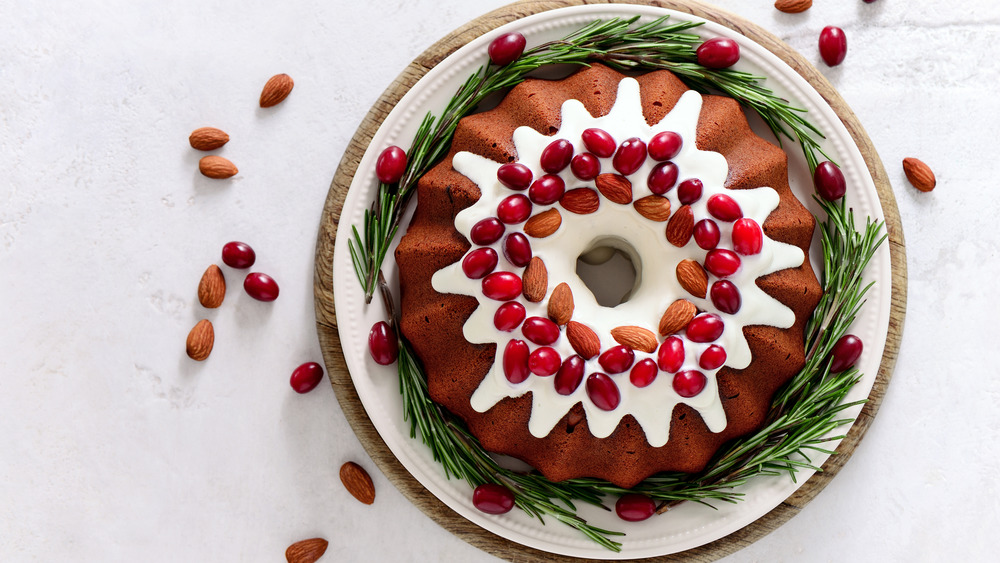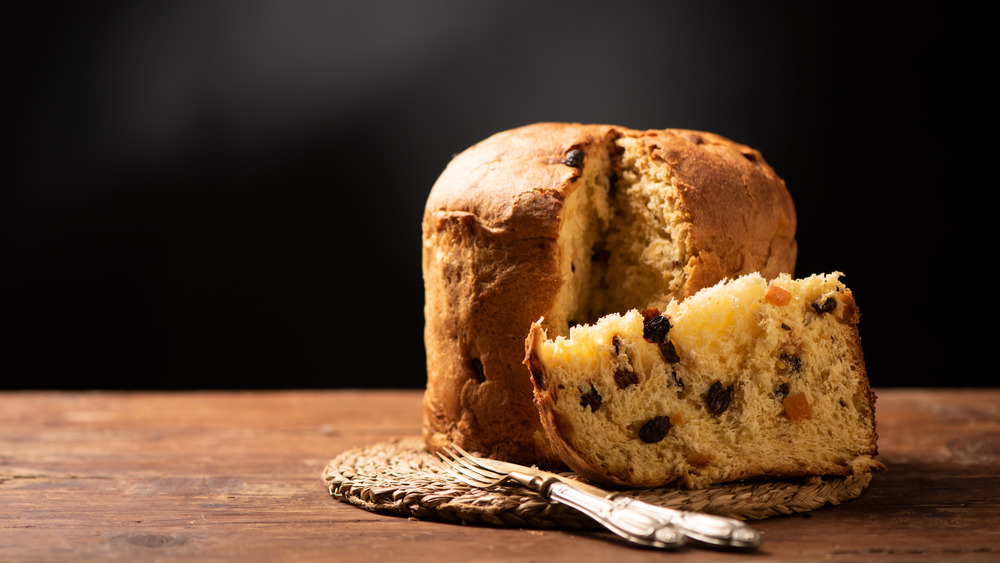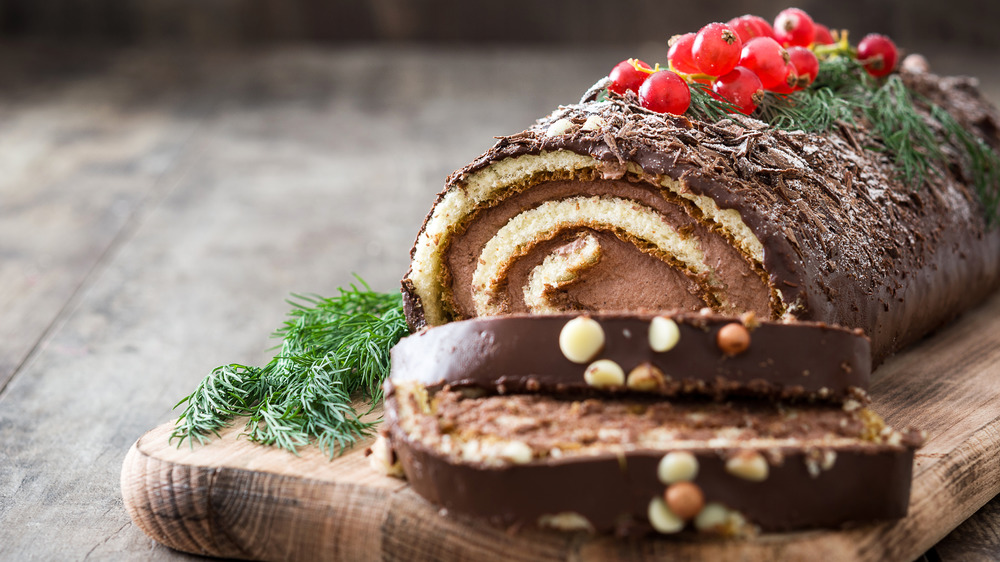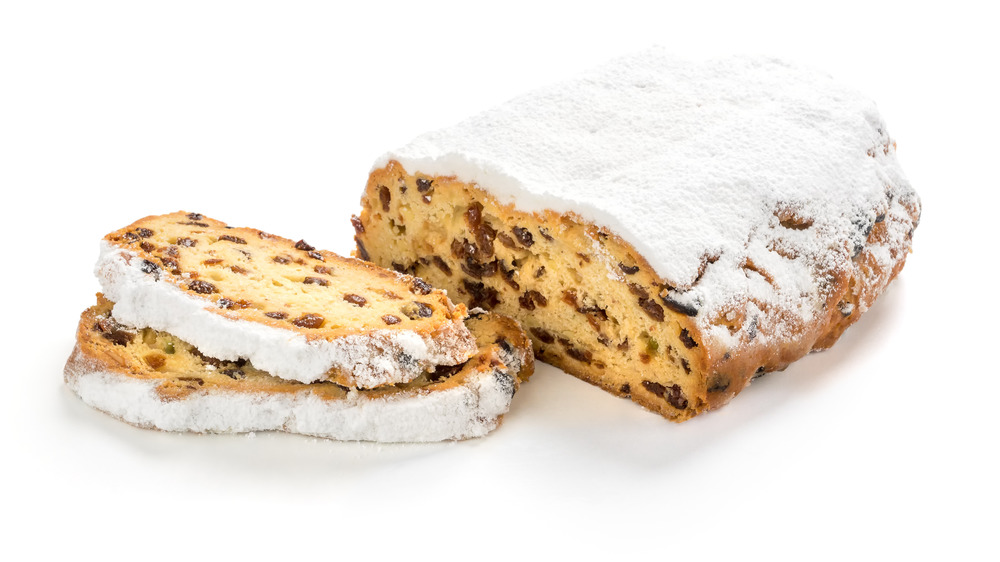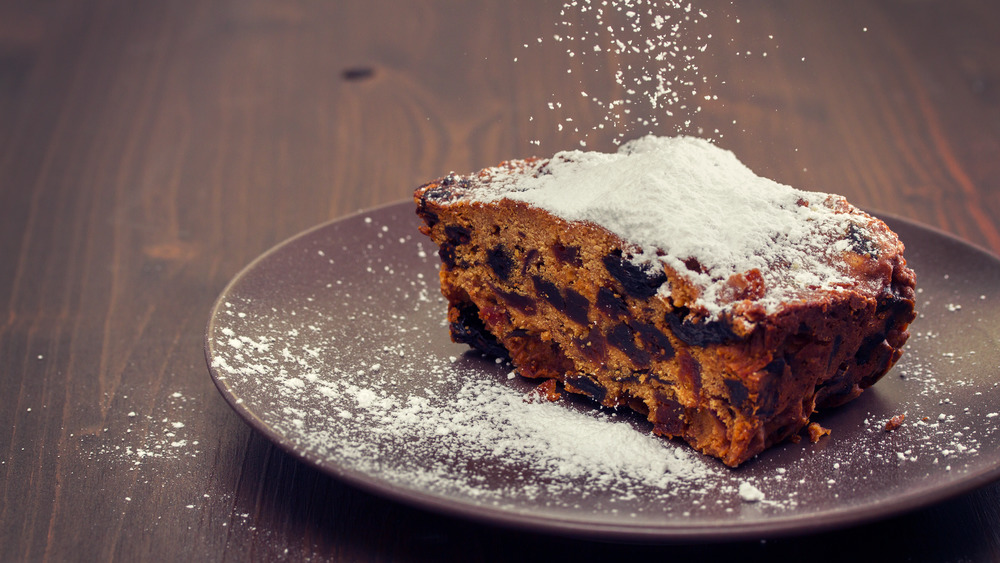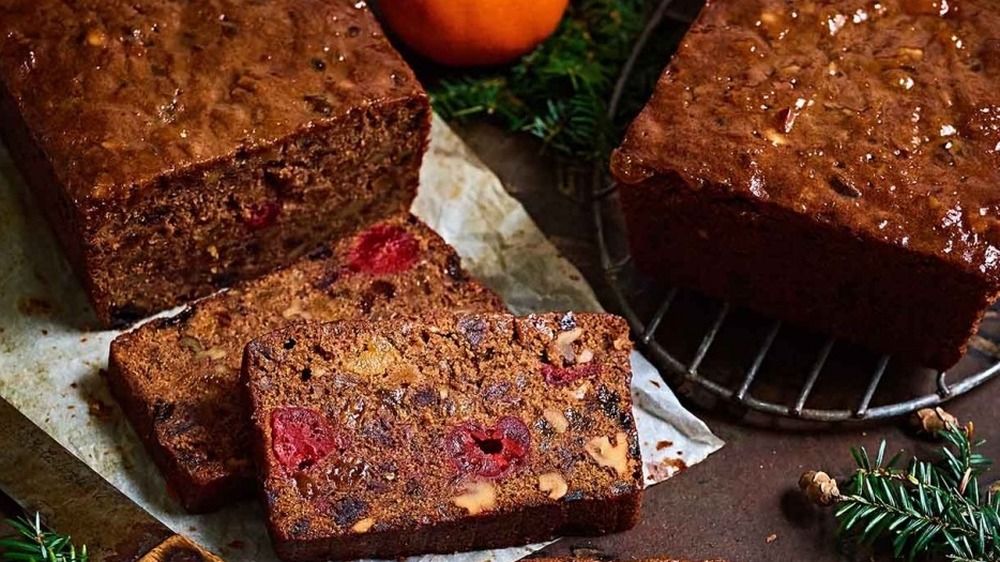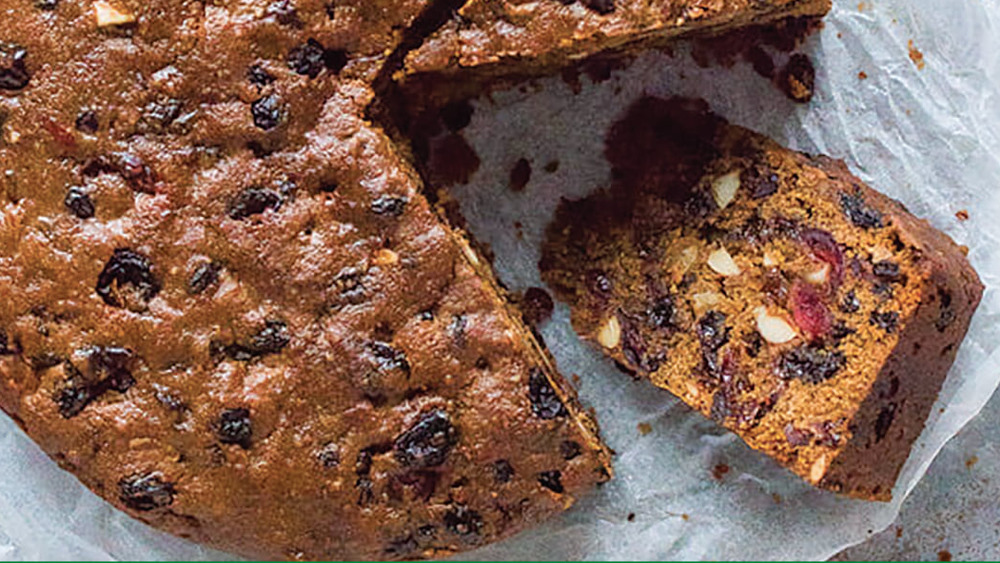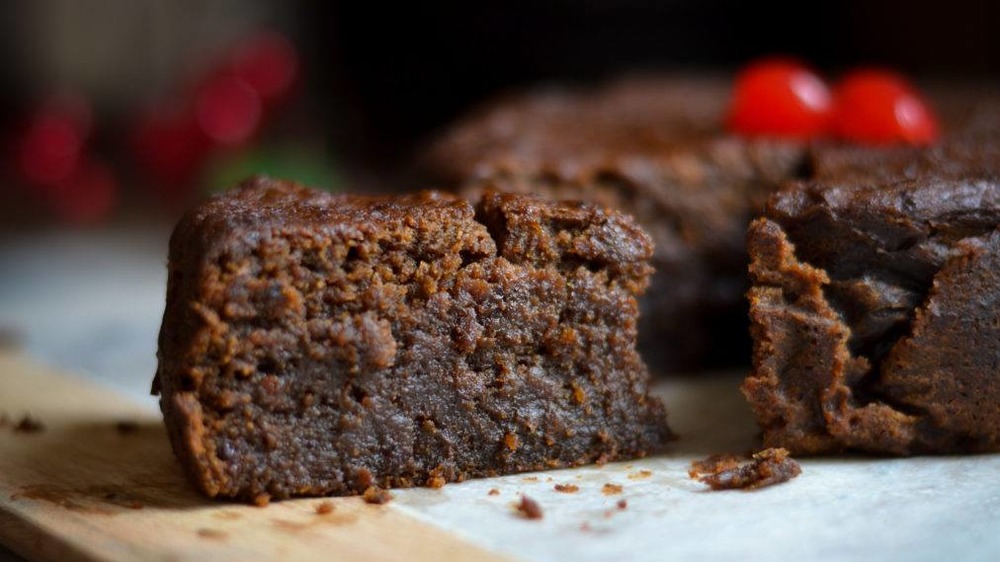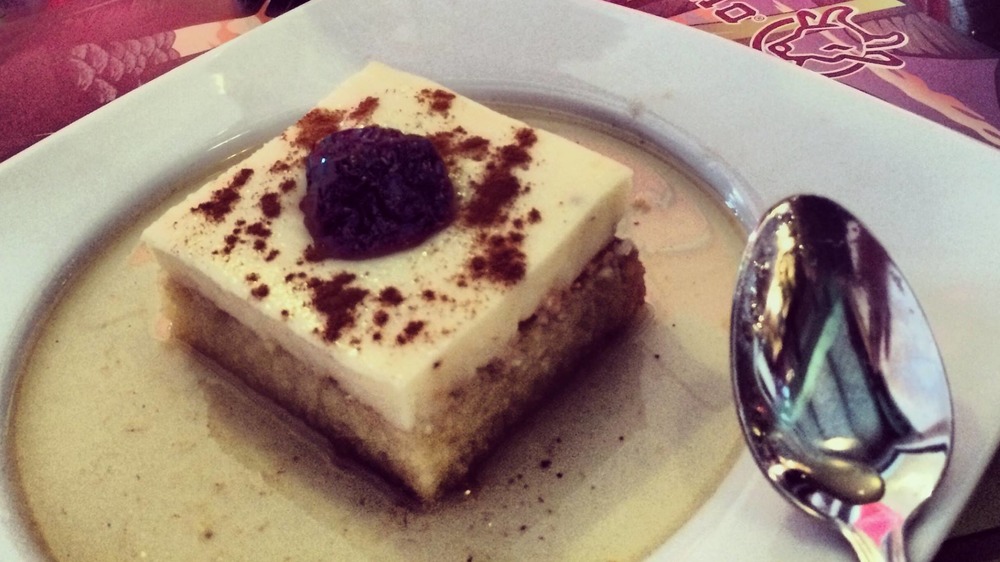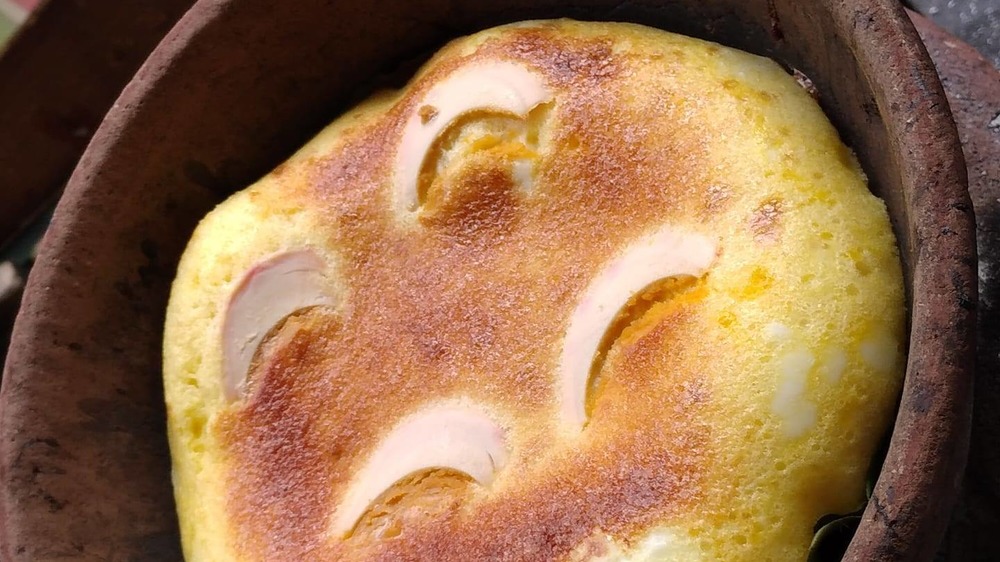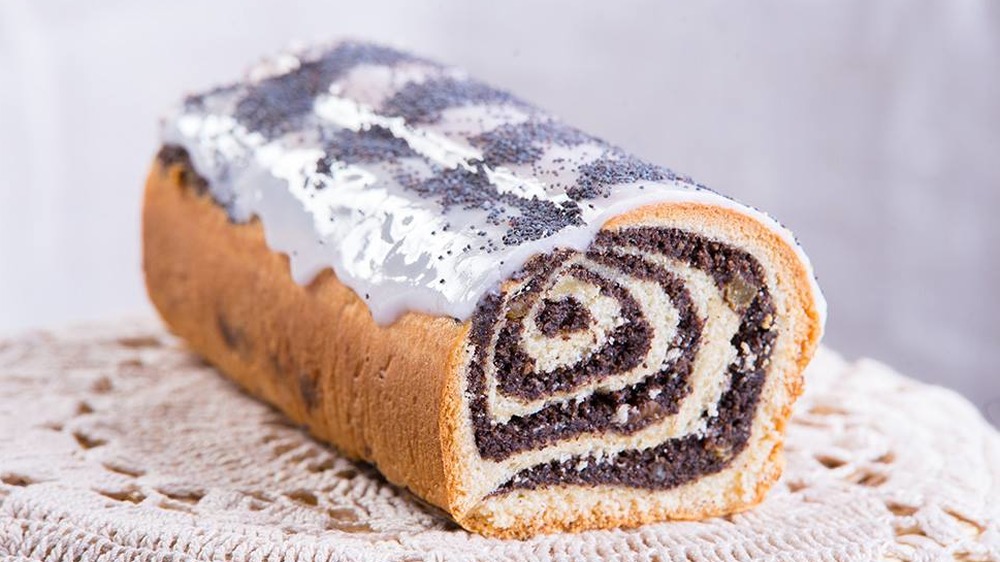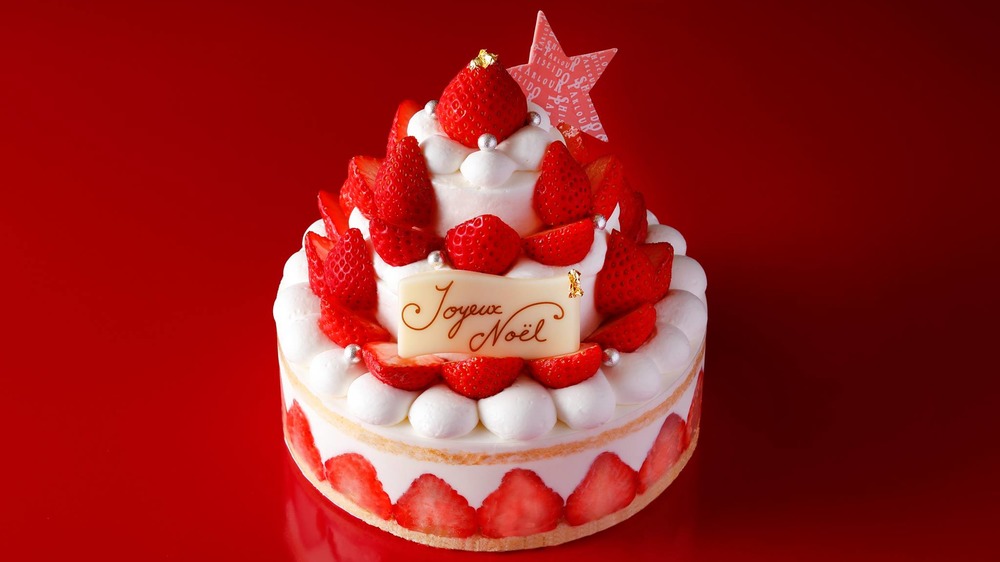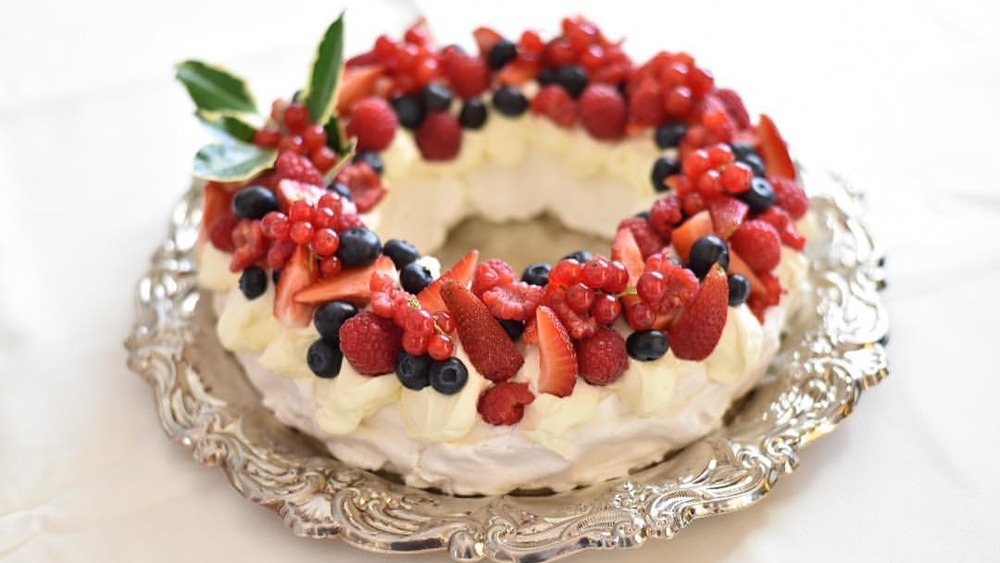The Best Christmas Cakes From Around The World
As Marie Antoinette declared (or didn't): "Let them eat cake." While things subsequently went downhill quickly for the French queen, her famous last words were sound advice. Few things perk up Yuletide spirits like a Christmas cake. Tragically, in America, Christmas cake has become all too often synonymous with the kind of industrialized, dehydrated sickly sweet confection known as the fruitcake. A cake is in culinary trouble when it becomes a surefire recipe for late-night humor, with the likes of Johnny Carson quipping: "There's only one fruit cake in the entire world and people keep passing it around."
However, there's no need to despair when the world has you covered. Over the centuries, most Christmas-celebrating nations on the planet have perfected their own delicious brands of edible Yuletide bliss. Some of the most celebrated — English plum cake, French bûche de Noël, Italian panettone — have become justifiably ubiquitous throughout the planet. Yet unsung others — Poland's (literally) intoxicating poppy-seed makowiec, Nicaragua's custard-crowned Pio Quinto cake, Sri Lanka's cashew-crammed semolina Christmas cake — are equally Hallelujah worthy.
In our round-up, we've attempted to pay proper homage to the classics, while shining some light on some of the season's lesser-known divine delicacies. We consider the results to be among the best Christmas cakes in the world.
Panettone (Italy)
Could it be that the more delicious a cake, the more legends it inspires? The theory certainly applies to the fluffy, fruit-filled panettone, first mention of which dates to the 1470s. Of its many origin stories, the most delectable involves a scullery boy named Toni. When the Duke of Milan's chef burned the Christmas cake, Toni came to the rescue with a sweet loaf made out of leftovers. The improvised confection won such Dukely raves that it became known as Panettone ("Toni's bread").
For most of its history, panettone was a flattish "bread." Its rise in stature dates to 1919, when Milanese pastry chef Angelo Motta added yeast and allowed the dough to rise three times, for 20 hours, before baking it into a towering, dome-shaped loaf. Soon after, the first industrialized panettones came off bakery assembly lines in Milan. By then, panettone had gained worldwide popularity as northern Italian immigrants took the recipe with them to the Americas.
Today, it's as popular in New Jersey as it is in Peru and Brazil (Brazil's Bauducco is the biggest panettone maker on the planet, producing over 200,000 annual tons, of which only 10 percent is exported). While such global versions have innovated — some Peruvian panettones include coca flour and candied papaya — Italian bakers adhere strictly to official rules, which state that an authentic panettone must contain at least 20 percent candied fruit and 16 percent butter, among other sweet strictures.
Bûche de Noël or Yule Log (France, Quebec)
Like most Christmas traditions, the origins of the bûche de Noël (yule log) are downright pagan. In medieval France, on Christmas Eve it was customary for families to place a wooden log (preferably from a fruit tree) in the hearth — to guarantee a robust harvest in the new year. After sprinkling salt, holy water, and/or wine on top, the log would be lit, and would hopefully burn for at least three days. For extra luck, family members used leftover ashes and coals as protection against lightning strikes.
In both France and Quebec, this tradition continued well into the 1800s, when hearths gradually gave way to wood-burning stoves. Subsequently, yule logs were used to decorate dinner tables, a setting that inspired a more interactive, edible version. Invented in late 19th-century Paris, the mother of all bûches was a light sponge-cake, layered with pastry cream and rolled into a cylinder. To simulate a wood log, it received a coating of chocolate buttercream, with strategic rakings from a fork or serrated knife providing tree-like texture. Meringue mushrooms and marzipan leaves added extra botanical panache.
Today, there are countless riffs upon the classic recipe. Innovative pâtissiers use the simple log as a springboard for ambitious creations such as black lemon bûche with boiled, sun-dried Iranian lemons and a bûche layered with layers of sumac-flavored chocolate and pear jam.
Stollen (Germany)
Most people conjure up stollen as a dense German Christmas cake, fragrant with spices and heavy with candied citrus peels, currants and raisins, and almonds. Not only is the dough buttery, but the loaves are brushed with butter and dusted with powdered sugar.
None of this buttery richness defined the original stollen, the earliest reference of which dates to Dresden, in 1474. Served during the fasting period of the Advent, stollen was a decidedly unfestive mixture of flour, yeast, and water. At the time, the Catholic church forbade luxuries such as butter, but Prince Ernest, Elector of Saxony, entreated Pope Innocent VIII to revoke the butter ban. Miraculously, the Pope agreed, and in 1491 bakers were allowed to add butter and other waist-thickening ingredients to their stollen. It was actually in the Prince's self-interest to advocate for butter; a Dresden tradition involved gifting sovereigns with outsized stollen at Christmas time (the tradition hit its apex, in 1730, when elector Augustus commissioned a 1.8-ton stollen made by 100 bakers).
Today many stollen variations exist. However, the original version, known as Dresdner Christstollen, enjoys official status. Recognized by the European Commission, it's still prepared according to the original 15th-century recipe which, according to specialist Hans Röckenwagner, "is mostly fruit held together with a little cake." Due to successive rising, resting, and ripening periods, the entire stollen process takes four days to prepare — but often fewer to demolish.
Christmas cake (England)
Modern-day fruitcake, a.k.a. Christmas cake, inspires as much loathing as it does loving. Smithsonian Magazine chalks up much of the loathing to early 20th-century, mass-produced, mail-order versions, which appeared, uninvited — and uninvitingly dry, stale, and pockmarked with cloyingly sweet candied fruit — on people's doorsteps. However, as British Christmas cake traditionalists are aware, if you're true to an original, home-baked recipe, it's easy to flip from loather to lover.
Classic English fruitcake is rich with eggs and butter, stuffed with quality glazed fruits, and steeped in intoxicating spirits such as whiskey or brandy. Food writer Marian Burros notes that ancient Romans had a version called satura, a mix of barley mash, dried raisins, pine nuts, and pomegranate seeds, doused in honeyed wine and spices. It's telling that another Roman invention — the literary form known as satire — was inspired by this confection jammed with ingredients both sweet and sour.
Known as plum cake, the English fruitcake enjoyed today appeared in the mid-17th century. Although countless versions exist (with and without frosting), the one constant is that you can never age a fruitcake too long. More important than how you bake the cake (slowly, on low heat) is how you store it: in a cool place, wrapped in booze-soaked cheesecloth and tightly covered, for weeks or even months before Christmas. As former White House pastry chef Roland Mesnier confessed, "They are even better the second year."
Allahabadi cake (India)
Although it shares some common ancestry with English Christmas cake, as The India Times proudly declares, Allahabadi cake is proudly, purely, and "unapologetically desi" (i.e. Indian). The country's most celebrated Yuletide confection takes its name from Allahabadi, a northern Indian city home to the prominent Anglo-Indian Christian community who concocted the recipe.
While featuring the rum-soaked dried fruits and almonds that are hallmarks of Britain's Christmas cake, Allahabadi cake ventures into new confectionary territory with the addition of many unique ingredients. Regular butter is replaced by homemade (and healthy) ghee while ginger, nutmeg, saunf (fennel seeds), and javitri (mace) hit pungent aromatic notes. Locally made marmalade makes an appearance as does petha, a jewel-hued candied fruit of the ash gourd (also known as white pumpkin). Petha's presence lends the cake a particularly illustrious aura. The delicacy was created at the behest of Shah Jahan, the Mughal king whose other notable commission was the Taj Mahal.
Echoing the mobs that visit the fabled marble mausoleum are those that line up at Allahabad's traditional bakeries come Christmas. As The Times of India reports, the city's namesake cakes are so sought after that customers have to book an appointment to pick up the finished cake — or else risk waiting outside all night on the sidewalk.
Sri Lankan Christmas cake (Sri Lanka)
There are Christmas cake fanatics who have tried every single variation possible and then, through luck, travel, or marriage, stumble upon the secret of what they deem to be the best of them all — from Sri Lanka. Food writer Rachel Bartholomeusz makes the case that Sri Lanka's Christmas cake has spread much more enthusiastically across the island nation than Christianity itself (to which only seven percent of the population adhere). That said, Sri Lankan's small Christian community boasts a heritage that reflects the island's complex history under Portuguese, Dutch, and British colonial rule. The multiple references and influences are manifest in a Christmas cake in which colonial culinary legacies mingle appetizingly with homegrown traditions and ingredients.
Sri Lankan Christmas cake's fundamental difference is its use of moist rulang (semolina) instead of wheat flour along with an abundance of ground cashews (brought to the island by the Portuguese). An obscene number of eggs — between 12 and 55 depending on the recipe — and even more egg whites ensure off-the-charts richness.
British colonists' penchant for strawberry jam explains why entire jars full are added to preserved local fruits (and vegetables!) including pumpkin and chow chow (chayote). Spice is decidedly Asian with ginger, cinnamon, and cardamom mingling with vanilla and rose water. Traditionally, the cake is coated with marzipan — made from local cashews instead of the usual almonds. A slice goes down particularly well with the classic accompaniment of milk wine.
Black cake (Caribbean)
Food writer Julia Moskin sums up the difference between classic Christmas fruitcake and Caribbean black cake with a succinct culinary metaphor. While she compares the former to milk chocolate, she sees the latter as akin to dark chocolate in that the Caribbean confection is "darker, deeper, and altogether more absorbing."
The metaphor is as apt as black cake's very name. Both allude to the use of the islands' homegrown brown sugar in addition to rich, dark cane molasses and a bittersweet caramel known as "browning." Black cake recipes draw upon the foundations of English Christmas cake that colonists brought to the British Caribbean islands. But while the cake showcases (expensive and imported) raisins and prunes instead of local pineapples and mangos, it also uses rum to generously drench these luxurious ingredients — sometimes for months. Prior to baking, the soaked, softened fruit is mashed into a paste that imbues the cake with its smooth texture and profound flavors.
Baked just before Christmas, black cake is served at Christmas dinner. However, the remains are proudly displayed on the table throughout the end-of-year holidays (if they last that long). There's never a concern that cake exposed for days will dry out; if it shows signs of dryness, the simple solution is to just top it off with more rum.
Pio Quinto Christmas cake (Nicaragua)
Nicaragua's Pio Quinto cake is another equally rum-soaked Christmas cake with origins near the Equator. The reason for honoring this Central American confection with the name of a 16th-century Pope known for his hard-core anti-heretic stance is shrouded in obscurity. However, there's nothing mysterious about why this relative of the tres leches cake (with the aforementioned rum filling in for milk) has earned a place as Nicaraguans' favorite holiday treat.
In lieu of three types of milk, Pio Quinto cake possesses its own holy trinity. Its foundation consists of a marquesote, or cake, prepared with a mixture of wheat flour and fine white cornmeal, along with cocoa powder, cinnamon, and milk. Spiced rum, spiked with dried raisins and prunes, is boiled into a thick syrup known as sopa borracha (which means "drunken soup"), which is then used to soak the baked cake. Subsequently, the moist marquesote is crowned with a layer of manjar, a rich milky custard infused with cinnamon and topped with raisins and prunes. Apart from its striking visuals, the resulting trifecta is rumored to be so sinfully delicious that not even Pius V, in all his reputed austerity, would be able to resist it.
Bibingka (Philippines)
Who says that Christmas cake has to be a dessert, or even sweet for that matter? In the Phillippines, bibingka is a beloved Christmas chewy yet tender rice cake served both as a dessert, as well as at breakfast after dawn mass (it's often sold outside churches).
The classic process of preparing bibingka is somewhat elaborate. The traditional batter consists of galapóng, a slightly fermented, sticky rice paste and coconut milk. Terra cotta containers are lined with banana leaves which are wrapped around the rice mixture and then topped with– and placed over — hot coals. While modern oven baking is quicker and less messy — mass-produced bibingka are made in molds and often resemble cupcakes — the old-school method yields a flat yet succulent cake with a surface that is delicately charred and subtly infused with the flavor of toasted bananas.
Things get especially interesting when toppings are added. Variations are endless. Both sweet and salty, they run the gamut from basic (butter, sugar, grated coconut) to rarified (jackfruit, durian, salted duck eggs). Scarfed down while still warm, bibingka is often accompanied by tsokolate (hot chocolate) or salabat (ginger tea). And in a sea of flour-y Christmas cakes, they're miraculously gluten-free.
Makowiec (Poland)
Undoubtedly, there are Christmas cake devotees around the world whose devotion veers upon addiction. But it's only in Poland that devouring the national yuletide confection of makowiec can lead to a "positive" drug test result.
Poland's potentially incriminating pastry is a strudel-like, poppy seed cake that, in keeping with Polish predilection, is mercifully not too sweet. While the cake itself is lovely, the star attraction is the poppy seeds. Ground to a thick, rich, paste, the lustrous jet black swirls contrast strikingly with the pale cake batter. Every Polish family supposedly plays its own riff on the basic recipe, with honey, apricots, walnuts, and raisins making frequent cameos. However, the overwhelming consensus is the more poppy seeds, the merrier.
This isn't just because poppy seeds are packed full of nutrients. Nor is it entirely due to the common belief in parts of Eastern Europe that eating poppy seeds brings luck and prosperity — which explains makowiec's end-of-year popularity. Consuming poppy seeds is also tantamount to bingeing on an opiate. That's because like makowiec, opium, morphine and heroin, are also made from poppies. As journalist Marek Kepa reveals, pastry cooks and law enforcement agents are aware of this. Even so, history is full of poppy-seed-loving pastry junkies testing positive for morphine, when their only crime is greedily devouring an excessive yet irresistible slice of makowiec.
Japanese Christmas cake (Japan)
Christmas cakes are truly a phenomenon in Japan and sold in both gourmet bakeries and at 7-Elevens. Even more phenomenal is that only around one percent of Japanese are Christian. In fact, Christmas isn't even a national holiday in Japan. As Japan scholar David Plath notes, the only Christmas ritual that the Japanese adhere to on December 24th — aside from gathering together to feast on KFC — is gathering together to eat their own version of Christmas cake.
Unlike most Christmas cakes, Japan's Kurisumasu Keki is light and simple, consisting of sponge cake, blanketed in peaks of whipped cream, and garnished with artfully arranged, ruby red strawberries. Lacking in religious significance, it's a highly edible symbol of commercialism and prosperity.
According to NPR, while sponge cake had been known in the island nation since the 17th century, its key ingredients — sugar, milk, and butter — were rare luxuries. After World War II, Japan was economically devastated and food shortages were widespread. Sweet treats, such as those distributed by American soldiers who helped Japan to rebuild in the 1950s, were highly coveted. They became symbols of American-style success that the Japanese emulated, along with a commercial version of Christmas, whose emblem — a round cake, in red-and-white — reflected the shape and colors of the national flag. As proof of its prominence in Japanese culture, look no further than your cell phone where you'll find two versions of the Christmas cake on the emoji keyboard.
Pavlova (New Zealand and/or Australia)
It's a testament to the deliciousness of the pavlova that a century after its "invention," both New Zealanders and Aussies are still fighting over who invented the classic Christmas dessert. The record has it that Prima Russian ballerina Anna Pavlova did swing by both countries when she was on tour in 1926, which coincides with the dessert's appearance in local recipe books. Authorship aside, both Aussies and Kiwis agree on the basic recipe: a crunchy meringue foundation with a marshmallowy-soft interior, piled high with seasonal fruits rising out of a sea of whipped cream.
In an attempt to settle the matter of recipe-ship definitively, a bi-national research team spent two years sifting through 20,000 newspapers and 10,000 cookbooks. Their conclusion was that not only did the pavlova long precede its namesake ballerina's tour, but its creation stemmed from a 19th-century American "meringue craze" brought about by the invention of the hand-cranked egg beater.
At least, both warring factions can take comfort in the fact that of all the Pavlova-inspired dishes – ranging from Pavlova ice cream (the U.S.) to frogs' legs à la Pavlova (France) — the only survivor that's more popular today than ever is the Kiwi and/or Aussie pavlova. As food writer Ewan Sargent points out, the "pav" is exceptional: "It's light and fluffy and anyone can make room for aerated egg whites. It's the lifeboat for those drowning in Christmas dinner."
